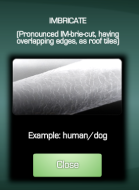Q
An intentional murder has occurred. The victim was stabbed several times. The culprit has not yet been discovered. There are three suspects that the investigators are suspicious of. They were confused between the three. Then, a strand of hair was discovered on the ground. They immediately got the warrant to get all suspects’ hair. What should one do as a forensic scientist?
************************************************************************************************
A
One should carry out a comparative analysis using the comparison microscope to compare the unknown hair and the suspects’ hairs.
************************************************************************************************
Hair is the outgrowth of filamentous cells co ntaining keratins from the follicles. A strand of hair can tell us a lot about the identity of the culprit. This is the structure of a strand of hair.
ntaining keratins from the follicles. A strand of hair can tell us a lot about the identity of the culprit. This is the structure of a strand of hair.
What distinguishes human hair from other species are the cuticle and medulla.
Two light sources can be used to examine a strand of hair: direct and oblique. Direct lighting is lighting from underneath. It shows the inner structures of the hair. Oblique lighting is lighting from the side. It highlights the cuticle of the hair.
Hair can have three scale patterns.
- Coronal
- Spinous
- Imbricate
1. Coronal
Coronal pattern has scales that look like stacked crowns or paper cups. An example is a bat’s hair.
2. Spinous
Spinous scale pattern has petal-shaped scales, protruding from the hair surface. The example of a spinous pattern is rabbit hair.
3. Imbricate
The scales of imbricate pattern are flattened to lie closer. Humans and dogs have this pattern.
There are three types of medulla.
- Continous
- Interrupted
- Fragmented/Absent

1. Continous
A continous medulla is the medulla formed in the center of the hair as a solid line. An example is the dog’s hair.
2. Interrupted
The medulla is seen as individual cells, as if it is fragmented. The pattern can be regular or irregular. The rabbits have this type of medulla.
3. Fragmented/Absent
There is almost no medulla in the hair. This is a characteristic of a human hair.
The follicular tag tells whether there is a nuclear DNA or not. The follicular tag surrounds the root, which is the site of hair growth. It supplies the hair with nutrients. When hair is pulled out, the follicular tag is sometimes removed. Even if there is none, we can still test for mtDNA, or mitochondial DNA.












Recent Comments